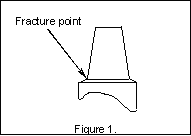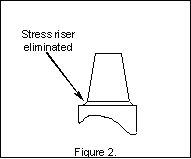
Want to dramatically improve
your up time?
Look at your core pin design.
Broken cores pins can be one of the most frequent causes of down time. Many of the causes can be eliminated or at least reduced. Following are some actions you can take that were effective in reducing the “down time” by 5 to 10 times.
• Automotive engine component
• 380 aluminum
• Each cavity contained 16 cores, 0.257 inch, (6.52 mm) diameter X 0.625
inch (15.87 mm) long.
• In addition there were 5 cores, 0.406 inch (10.31 mm) diameter X 0.625
inch (15.87 mm) long.
• Four cavity die
• Total 64 small cores per die
• Total 20 larger cores per die
• Open and shut construction with no slide cores
• The casting design specified a chamfer for each hole. The chamfer would
be similar to that created by a machined chamfer.
• The chamfer contained a sharp corner that was a stress riser.

• At least one core breakage occurred every day.
• The core breakage always occurred at the same point. The sharp corner
at the transition from the small diameter at the base of the chamfer.
• As many as 75 broken cores per month was normal
• Depending on scheduling, the die would immediately be shut down to replace
the broken core. However, if set up or die repair were unavailable, then the
tool would continue to run and the part with the broken core would be scrapped.
In other words, at least 25 % of the parts were scrapped until the repair was
made.
• Tear down and replacement was at least 2 hours per broken core from
detection to resuming production.
• Down time ranged from 40 to 150 hours per month. This was 10 to 38%
down time for a single cause.
• Solution:
o The customer was contacted to renegotiate the chamfer. We proposed a full
radius and marked up a drawing comparing the lead-in of the two concepts. Their
main concern was for ease of assembly. Ours was tool reliability.
o The design change was approved.
o The cores were replaced with a design that eliminated the stress risers. (Full
radius at the base).

Results:
• Core breakage was reduced to average of once per week or 8 to 12 hours
per month. (4 to 6 cores per month)
• We were able to complete our monthly orders and have machine time available
to run other castings.
• The tool room had extra time now that they didn’t have to make
all the replacements.
• Start up scrap was reduced now that the machine was able to run more
consistently.
Conclusions:
• Using radii to eliminate stress risers in die construction is good economic
practice.
• Make radius specifications a part of your quoting check list and AQP
(Advance Quality Planning).
Return to
“Technical articles Index page”.
Contact information:
Bob McClintic
McClintic & Associates
mailto: RMcClintic@DrDieCast.com
Web site: www.DrDieCast.com